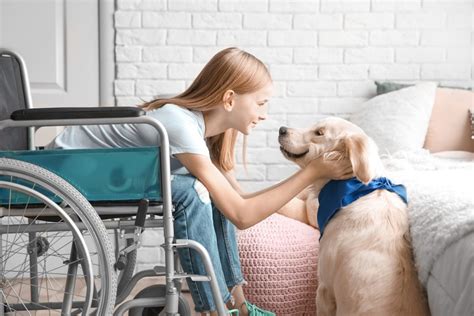Introducing From Furry Friend to Therapy Dog: Unleashing the Healing Power of Pets
In recent years, the use of animal-assisted therapy has gained popularity for its incredible impact on mental, emotional, and physical well-being. From reducing stress and anxiety to providing comfort and companionship, pets have proven to be powerful allies in promoting overall health. In this blog post, we will explore the many benefits of animal-assisted therapy and the role that pets play in improving mental health. We will also discuss how animals provide emotional support and the process of training and certifying therapy dogs. Additionally, we will provide valuable insights into preparing your pet for therapy work, and offer guidance on choosing the right animal for therapy. We will also delve into the profound impact of therapy dogs on physical health and their role in schools and hospitals. Join us as we uncover the transformative influence of pets in unleashing the healing power of animal-assisted therapy.
The Benefits of Animal Assisted Therapy
Animal assisted therapy can be incredibly beneficial for individuals struggling with physical or mental health issues. Whether it’s a therapy dog, cat, horse, or even a rabbit, animals have the ability to provide comfort and companionship to those in need. The non-judgmental nature of animals and their unconditional love can help reduce feelings of loneliness, anxiety, and depression.
One of the key benefits of animal assisted therapy is the improvement in socialization skills for individuals, especially those with autism spectrum disorder, intellectual disabilities, or other behavioral challenges. The presence of an animal can help individuals feel more at ease in social situations, leading to increased confidence and communication skills.
Furthermore, the physical benefits of animal assisted therapy cannot be overlooked. Interacting with animals can lead to lowered blood pressure, decreased heart rate, and reduced levels of stress hormones. This can ultimately have a positive impact on overall physical health and well-being.
In addition, the sense of purpose and responsibility that comes with caring for an animal through therapy can also provide individuals with a greater sense of self-worth and fulfillment. This can be particularly valuable for those struggling with feelings of loneliness or lack of purpose.
The Role of Pets in Improving Mental Health
Many people are aware of the companionship that pets provide, but their role in improving mental health is often overlooked. Having a pet can significantly reduce feelings of loneliness and provide a sense of purpose and responsibility. The presence of a pet can also help to decrease symptoms of anxiety and depression, as the act of caring for an animal can be a source of comfort and routine in an individual’s life.
Studies have shown that interacting with animals can lead to a release of oxytocin, a hormone that promotes bonding and reduces stress. This can have a calming effect on individuals, especially those with mental health disorders. Additionally, the routine and exercise that comes with pet ownership can also contribute to a healthier lifestyle, which in turn can positively impact mental well-being.
Therapy animals, such as therapy dogs and cats, are specifically trained to provide comfort and support in therapeutic settings. These animals can have a profound impact on individuals struggling with mental health issues, providing a source of comfort and non-judgmental companionship. Their presence has been shown to reduce feelings of anxiety and agitation, and increase feelings of relaxation and happiness.
Overall, the role of pets in improving mental health is undeniable. Whether it’s through the companionship of a personal pet or the support of a therapy animal, the presence of animals can have a positive impact on mental well-being, providing comfort, companionship, and routine to individuals in need.
How Pets Provide Emotional Support
Many people turn to pets for comfort and support during difficult times. Whether it’s a loyal dog, a cuddly cat, or a small rodent, animals have a unique ability to provide emotional support to their owners.
One way that pets offer emotional support is through their unconditional love and companionship. They are always there to provide a listening ear or a comforting presence, no matter what the circumstances may be. This can be especially beneficial for individuals who are dealing with feelings of loneliness or isolation.
In addition, pets have been shown to have a calming effect on their owners. Spending time with a pet, whether it’s playing with them or simply petting them, can help to reduce stress and anxiety. This is why many therapy animals are brought into hospitals and nursing homes to provide comfort to patients.
Furthermore, the responsibility of caring for a pet can also have a positive impact on a person’s mental well-being. Having a routine and a sense of purpose in taking care of another living being can help to improve mood and alleviate symptoms of depression.
Training and Certification for Therapy Dogs
Training and certification for therapy dogs is a crucial process that ensures the safety and effectiveness of the animals in their roles. Therapy dogs must undergo specialized training to ensure that they are well-behaved, obedient, and able to handle the various situations they may encounter in their work. This training typically involves basic obedience as well as specific skills related to interacting with people in need.
Once the training is completed, therapy dogs must be certified by a reputable organization. This certification verifies that the therapy dog has met certain standards of behavior and is suitable for work in environments such as hospitals, nursing homes, and schools. It also ensures that the dog and its handler are prepared to provide the necessary support and assistance to those they encounter.
It’s important to note that not all dogs are suitable for therapy work, and the training and certification process helps to identify those who are best suited for this important role. Different organizations may have specific requirements for therapy dog certification, but in general, the goal is to ensure that the animals are well-behaved, gentle, and able to remain calm and focused in potentially stressful situations.
Overall, training and certification are essential steps in the process of preparing therapy dogs for their important work. By ensuring that these animals are well-trained and properly certified, we can be confident in their ability to provide comfort, support, and companionship to those in need.
Preparing Your Pet for Therapy Work
Preparing your pet for therapy work can be a rewarding experience for both you and your furry friend. It’s important to remember that not all animals are suited for this type of work, so it’s essential to carefully consider your pet’s temperament and behavior before pursuing therapy training. The first step in preparing your pet for therapy work is to ensure that they have a calm and friendly demeanor. This is crucial for interacting with different individuals in a variety of settings.
Another important aspect of preparing your pet for therapy work is ensuring that they are well-trained and obedient. Basic obedience skills such as sit, stay, and come are essential for therapy animals to have in order to be successful in their roles. It’s also important to expose your pet to a variety of different environments and situations to ensure that they are comfortable and adaptable in new surroundings.
Additionally, it’s crucial to have realistic expectations when preparing your pet for therapy work. While therapy animals can have a positive impact on the individuals they interact with, it’s important to remember that not all animals are suited for this type of work. If your pet shows signs of stress or discomfort during training or interactions, it may be best to reconsider their suitability for therapy work.
Lastly, it’s important to seek guidance and certification from an accredited therapy animal organization. These organizations can provide valuable resources and support to assist in preparing your pet for therapy work. They can also offer guidance on the requirements and standards for therapy animal certification, ensuring that your pet is properly equipped for their new role.
Choosing the Right Animal for Therapy
When considering animal-assisted therapy, it’s important to choose the right animal for the job. Different animals have different temperaments and abilities, so it’s essential to select an animal that will be well-suited to the specific needs of the therapy program.
Dogs are the most common choice for therapy work due to their loyal and affectionate nature. They are highly trainable and can provide comfort and emotional support to those in need. Cats can also be great therapy animals, particularly for individuals who may be allergic to dogs or prefer a more independent pet.
For those looking for a more unconventional therapy animal, horses can also be incredibly effective. Equine-assisted therapy has been shown to help individuals with a wide range of physical and mental health issues. In some cases, smaller animals such as rabbits or guinea pigs may be a better fit, particularly for children or individuals in a hospital or school setting.
Ultimately, the right animal for therapy will depend on the specific needs of the program, as well as the individual needs of the people being served. It’s important to carefully consider the unique characteristics and abilities of different animals in order to choose the best fit for the therapy work at hand.
The Impact of Therapy Dogs on Physical Health
Therapy dogs have become an integral part of healthcare for many individuals, and their impact on physical health cannot be overstated. These specially trained dogs provide a unique form of support that has been shown to have numerous benefits for people dealing with a wide range of medical conditions.
One of the primary ways in which therapy dogs contribute to physical health is through their ability to reduce stress levels in patients. Interacting with a friendly and affectionate animal has been found to lower blood pressure and decrease the production of stress hormones, which can have a positive impact on a person’s overall well-being.
Furthermore, therapy dogs have been known to improve physical mobility in individuals with certain disabilities or mobility limitations. The presence of a therapy dog can encourage patients to engage in physical activities, such as walking or playing, which can be beneficial for their muscles and overall physical health.
In addition, therapy dogs have also been shown to have a positive effect on pain management. Studies have indicated that spending time with a therapy dog can lead to a reduction in the perception of pain, as well as a decrease in the need for pain medication in some cases.
Therapy Dogs in Schools and Hospitals
Therapy dogs play a vital role in providing comfort and support to students and patients in schools and hospitals. These specially trained dogs are capable of helping individuals cope with stress, anxiety, and other emotional challenges. The presence of therapy dogs in these environments has been shown to have a positive impact on the mental and emotional well-being of those they interact with.
Studies have demonstrated that interactions with therapy dogs can help reduce feelings of loneliness and isolation among students and patients. The unconditional love and non-judgmental nature of dogs create a sense of calm and security in these settings, making them valuable assets in promoting a nurturing and healing environment.
Furthermore, the use of therapy dogs in schools and hospitals can help improve social skills and promote a sense of community. Children and adults alike benefit from the companionship and affection provided by these animals, fostering a sense of connection and empathy among individuals who may be experiencing difficult or challenging circumstances.
In addition to their role in providing emotional support, therapy dogs in schools and hospitals have also been found to have a positive impact on physical health. The act of petting and interacting with a dog can help lower blood pressure, reduce heart rate, and alleviate physical symptoms of stress, contributing to an overall sense of well-being.





